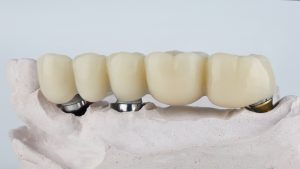Reconnecting Your Smile: Implant-Supported Bridges in Kirkland
Missing more than one tooth in a row? Implant-supported bridges offer a strong and stable way to restore your smile without impacting your healthy teeth. Discover how Dr. Roberts at Dentiste, one of the best dentists in Kirkland, can bridge the gap between missing teeth with dental implants for a complete and confident you.
Call us today at (425) 284-0515 to explore your tooth restoration options. We welcome patients in Kirkland and neighboring communities such as Redmond and Bellevue.
Local Dentists, Reliable Results: Choosing Dr. Roberts
If you’re seeking dependable dental care in the Kirkland, WA area, perhaps near the scenic Kirkland Waterfront, the vibrant shops of Downtown Kirkland, or even the convenient Totem Lake area, look no further than Dentiste. Dr. Roberts and our dedicated team are committed to delivering results you can trust, right here in your community.
Choosing a local Kirkland dentist means you’re selecting a practice that understands the needs of our community. Take the first step towards reliable dental results. Call Dentiste today at (425) 284-0515 to schedule your appointment with Dr. Roberts. We are dedicated to helping you achieve the healthy, beautiful smile you deserve, right here in Kirkland.
What Are Dental Implant-Supported Bridges?
Implant-supported bridges are a way to replace multiple teeth in a row using dental implants for support, instead of relying solely on adjacent natural teeth like traditional dental bridges. Think of them as a combination of the stability of dental implants and the tooth-replacement capability of a dental bridge.
Instead of dental crowns on natural teeth holding the artificial teeth (pontics) in place, the bridge is anchored to strong, artificial tooth roots that have been surgically placed in your jawbone.
How Do Fixed Implant-Supported Bridges Work?
Implant-supported bridges, a tooth replacement solution offered by Dr. Roberts at Dentiste in Kirkland, WA, work by using the stability of dental implants to support one or more artificial teeth, effectively “bridging” the gap left by multiple missing adjacent teeth. Here’s a breakdown of the process:
- Strategic Implant Placement: Instead of placing an implant for every missing tooth, Dr. Roberts strategically places two or more dental implants in the jawbone where the teeth are missing. The number of implants needed depends on the length of the bridge and the quality of your jawbone.
- Osseointegration: Just like with single dental implants, these placed implants undergo osseointegration, the process where the titanium post fuses directly with your jawbone. This creates a strong and stable foundation.
- Abutment Connection: Once the implants are securely fused, small connector posts called abutments are attached to the implants. These abutments extend above the gum line and will serve as anchors for the dental bridge.
- Custom-Designed Bridge: The dental bridge itself consists of one or more artificial teeth (pontics) that fill the gap. These pontics are attached to crowns on either end, which will be securely fitted onto the abutments connected to the implants. The bridge is custom-designed to match the color, shape, and size of your natural teeth for a seamless appearance.
- Secure Attachment: The implant-supported bridge is then permanently attached to the abutments. The implants bear the chewing forces, providing excellent stability and preventing the bridge from shifting or moving, unlike traditional bridges that rely solely on adjacent teeth for support.
Benefits of Implant-Supported Dental Bridges
Choosing implant-supported bridges offers several advantages for individuals in the Kirkland area with multiple missing teeth:
Enhanced Stability: Implants provide significantly more stability compared to traditional bridges or removable dentures, allowing for confident chewing and speaking.
- Preservation of Natural Tooth Structure: Unlike traditional bridges, implant-supported bridges do not require altering or placing stress on adjacent healthy teeth.
- Prevention of Bone Loss: Dental implants stimulate the jawbone, helping to prevent the bone resorption that can occur after tooth loss.
- Natural Look and Feel: Implant-supported bridges can be designed to look, feel, and function very much like your natural teeth.
- Durability and Longevity: With proper care, implant-supported bridges can last for many years, often longer than traditional bridges or dentures.
Candidacy for Dental Implant Bridge Placement
Being a suitable candidate for an implant-supported bridge at Dentiste typically involves:
- Having multiple adjacent missing teeth: This is the primary reason for considering this option.
- Sufficient and healthy jawbone: The jawbone needs to be strong enough to support the placement of dental implants that will anchor the bridge.
- Good overall health: Candidates should be in good general health to undergo the implant placement surgery and the healing process.
- Healthy gums: The gums surrounding the implant sites need to be healthy and free from significant disease.
- Commitment to oral hygiene: Maintaining a rigorous oral hygiene routine is crucial for the long-term success of the implants and the bridge.
Dr. Roberts will conduct a thorough evaluation to determine if an implant-supported bridge is the right solution for your specific needs. Call (425) 284-0515 to learn more.
Caring for Implant-Retained Bridges
Maintaining an implant-retained bridge involves a combination of at-home care and regular professional check-ups at Dentiste:
- Brushing: Brush your bridge and surrounding gums at least twice a day using a soft-bristled toothbrush and non-abrasive toothpaste. Pay extra attention to the areas around the implants and under the bridge.
- Flossing: Floss daily using unwaxed floss, a floss threader, or an interdental brush to clean under the bridge and around the implant abutments. This helps remove plaque and food particles.
- Water Flosser: A water flosser can be a beneficial tool for cleaning hard-to-reach areas around the implants and under the bridge.
- Regular Dental Visits: Attend regular check-ups and professional cleanings at Dentiste as recommended by Dr. Roberts. These appointments allow us to monitor the health of your implants, the stability of the bridge, and ensure thorough cleaning with specialized instruments.
Frequently Asked Questions
Implant-supported bridges can last 10 to 20 years or more with proper care and regular dental checkups. The lifespan of your implant bridge depends on your oral hygiene, lifestyle factors like smoking, and the quality of the materials used.
Implant-supported bridges are typically fixed and not removable by the patient, as they’re securely attached to dental implants. In some cases, a dentist can remove them for maintenance or replacement if needed.
In Kirkland, implant-supported bridges cost between $5,000 and $15,000, depending on the number of implants needed and the number of missing teeth being replaced. Additional procedures like bone grafting may increase the cost.
Typically, two to four implants are needed to support a dental bridge, depending on the number of missing teeth and the bridge’s design. Our dentist will assess bone density and oral health to determine the exact number.
Replace Missing Teeth and Restore Your Confidence in Kirkland
Imagine the renewed confidence of a complete smile, allowing you to enjoy the vibrant life of Kirkland without hesitation. Dr. Roberts and the caring team at Dentiste are ready to guide you through this transformative process.
We welcome new patients from Kirkland, Redmond, Bellevue, and beyond. Take the first step towards a stable and seamless smile. Call us today at (425) 284-0515 for a dental implant consultation!

 Enhanced Stability: Implants provide significantly more stability compared to traditional bridges or removable dentures, allowing for confident chewing and speaking.
Enhanced Stability: Implants provide significantly more stability compared to traditional bridges or removable dentures, allowing for confident chewing and speaking.